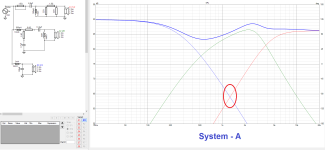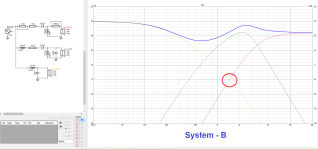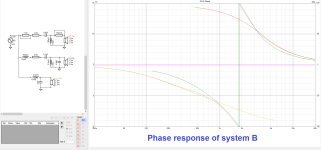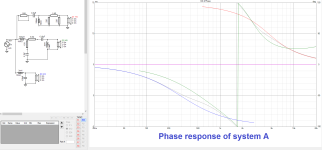I have two different speaker systems that have identical frequency response. They're both three-way.
System A, the "woofer" and "tweeter" meet each other at 64dB, while system B, they meet at 70dB. As stated earlier, two systems are tuned to have their frequency responses identical (or very close) to each other.
Will it have any sound difference between the two? Which one is better?
System A, the "woofer" and "tweeter" meet each other at 64dB, while system B, they meet at 70dB. As stated earlier, two systems are tuned to have their frequency responses identical (or very close) to each other.
Will it have any sound difference between the two? Which one is better?
Attachments
Vituixcad can show you the differences when it is given multiple angle data to work with.
Probably. But the crossing point between woofer and tweeter is completely irrelevant.Will it have any sound difference between the two?
Both are not good. There is a 7 dB drop at 600 Hz. Highpass of the mid seems too high for both variants.Which one is better?
But, there’s about 5dB difference. Maybe listener could hear it?But the crossing point between woofer and tweeter is completely irrelevant.
I intended to make it non-flat FR curves. They’re for study purpose.Both are not good. There is a 7 dB drop at 600 Hz. Highpass of the mid seems too high for both variants.
Why would that be? The mid output is about 20 dB stronger at that frequency.But, there’s about 5dB difference. Maybe listener could hear it?
You are mostly moving the crossover frequency of the woofer and midrange (and a tiny bit of tweeter adjustment). Directivity and distortion of the system can change, even if the on-axis response is similar.
Here you are.Vituixcad can show you the differences when it is given multiple angle data to work with.
It will be very exciting to acknowledge these plots, as they are quite advanced for me.
Please advise me.
Attachments
Directivity and distortion of the system can change, even if the on-axis response is similar.
Just to expand on this, as I think this is the important point in practice.
A real woofer may have cone breakup (not evident in your graphs) and where is the tweeters rising distortion as well as Fs. Being 6 db lower for all of these things would be good...IF they are actually important for real drivers in a real situation. But it is also possible that the woofers are well behaved, the tweeter has low distortion at 1,500hz and the tweeter has a low Fs and there is no audible difference between the two. Just depends on the actual drivers in the real world.
IF both systems have exact same frequency response, not sure how any Human ear can perceive "where they meet"
And the relevant parameter is crossover frequency rather than "SPL at crossover frequency"
I mean in a properly made flat response speaker system ; your example is far from that.
And the relevant parameter is crossover frequency rather than "SPL at crossover frequency"
I mean in a properly made flat response speaker system ; your example is far from that.
- Home
- Loudspeakers
- Multi-Way
- 65dB versus 70dB



